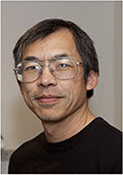


Posted May 23, 2013
Charles Lin, Ph.D., Massachusetts General Hospital
 Using a new microscope developed in his lab for cell tracking in live animals, Dr. Charles Lin and his collaborators made a surprising observation. They imaged the bone marrow of mice that had been transplanted with fluorescently labeled, allogeneic blood stem cells, expecting to observe rejection. What they found, however, was that the cells survived for more than a month without immune suppression. Without immune-suppression to ensure the host immune system does not reject and attack the foreign bone marrow cells, the transplanted bone marrow cells should have died.
Using a new microscope developed in his lab for cell tracking in live animals, Dr. Charles Lin and his collaborators made a surprising observation. They imaged the bone marrow of mice that had been transplanted with fluorescently labeled, allogeneic blood stem cells, expecting to observe rejection. What they found, however, was that the cells survived for more than a month without immune suppression. Without immune-suppression to ensure the host immune system does not reject and attack the foreign bone marrow cells, the transplanted bone marrow cells should have died.
Dr Lin's collaborative team of scientists, with expertise in microscopic imaging, hematopoesis, and immunology, investigated the observed phenomena. When they repeated their imagining experiment, they observed a group of immune-suppressive cells, regulatory T lymphocytes, along with the transplanted stem cells. The team found that the regulatory T cells and the transplanted stem cells clustered together in an area of the bone marrow known as the stem cell niche, a specialized microenvironment that provides support to stem cells for functions such as self-renewal and differentiation into blood cells. Based on these observations, Dr. Lin was awarded a Fiscal Year 2009 Bone Marrow Failure Research Program Exploration - Hypothesis Development Award to test the hypotheses (1) that in addition to providing environmental support and regulatory signals, the bone marrow stem cell niche also provides a protective sanctuary, endowed with immune privilege mechanisms, where stem cells are protected from immune attack and (2) that regulatory T cells are a key component in establishing immune privilege within the stem cell niche. The results of this study confirmed that the niche provides protection to stem cells from immune attack but also demonstrated that the immune privilege of the stem cell niche is mediated by regulatory T cells through an interleukin-10-dependent mechanism. Regulatory T cells may protect an individual's own blood stem cells from autoimmune attack in addition to protecting transplanted blood stem cells from host immune rejection. This research has important implications for bone marrow failure patients because it suggests that boosting immune protection in the auto-immune phase of bone marrow failure, or in the transplantation setting, are potential treatment strategies. This work was published in Nature, June 2011, and featured in The New England Journal of Medicine, September 2011.
Publication:
Fujisaki J, We J, Carlson AL, Silberstein L, Putheti P, Larocca R, Gao W, Saito TI, Lo Celso C, Tsuyuzaki H, Sato T, Cote D, Sykes M, Strom TB, Scadden DT, and Lin CP. 2011. In vivo imaging of Tregs providing immune privilege to the hematopoietic stem cell niche. Nature 474(7350):216-219. PMID 21654805.














